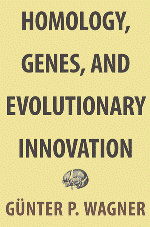Homology, Genes, and Evolutionary Innovation
 Gunter P Wagner
Gunter P Wagner
Princeton University Press, £27.27
This is a book I've waited for all of my professional life (plus a bit – I'm 80). Wagner is a giant in the evo-devo field – or, as he says, more properly 'devo-evo' (developmental evolution). I used to give my tutorial students de Beer's little book Homology: An Unsolved Problem, then Steve Gould's Ontogeny and Phylogeny to introduce them to what I thought was a central issue of biology: when we say that a bat's wing, your arm and a seal's flipper are the 'same' thing, what do we mean by 'same'?
Wagner writes: "Homology is the same organs regardless of form and function" (his italics). He means that the genes of the 'character identity network' (ChIN) have been more or less the same since the common ancestor, despite changes in target genes/phenotype. (An important criticism of this book is that his acronyms – ChIN, for example – are not in the index.)
He uses as informative examples a very wide spectrum: newt balancers/frog cement glands, the turtle carapace, Drosophila sex combs, tetrapod digits, feathers (where, in my view, he's rather too committed to his colleague Richard Prum's ideas), and flowers.
The angiosperm chapter contains a few spelling errors and is not as elegantly edited as the rest of the book, but nevertheless it adds to the argument.
Now that we have illuminated so many genetic pathways, the depth of analysis is frequently adequate as explanation. Modern biologists will be able to follow this much more easily than me – but, alas, my experience suggests that they're no longer very interested in this most basic biology.


